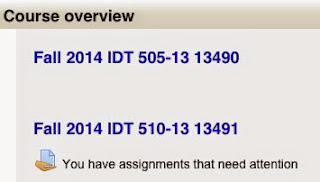
As this is the year 2014, there are things that you would expect to be able to do online with your college program. California State University, Fullerton has a robust student interface that allows students to apply for programs and purchase textbooks, as well as to enroll and pay for classes online. But for the MSIDT program, all of the classwork is conducted online. How can that possibly work while still providing student interaction and encouraging participation? The answer is the TITANium Moodle system.
Moodle is much maligned in the academic world because it is kind of a clunky old interface that is not visually appealing, and it has many features that are redundant and unnecessary, but it worked just fine for my first term.
For the first two courses, IDT 505 Foundations of Instructional Design and Web Authoring Tools and IDT 510 Research Practices in Instructional Design and Technology), the professors posted assignments for each week on Sunday or Monday, with homework assignments that included readings, short assignments, and quizzes, as well as major assignments that included the submission of learning objects and research papers.

But the heart of this online experience was the discussion forum for each course. For many weeks the instructors would provide a prompt (e.g. a reading assignment or a video to watch) and then it was the students’ responsibility to post their thoughts on the subject and have online discussions with the other students. This was helpful in helping to define the instructional design process, as it provided the opportunity to learn from the others’ experiences and to gain consensus.

The final output of many of the major assignments were posted to the forums as well. It is helpful to have another 28 sets of eyes take a look at a learning object you have created and to have them provide positive feedback, and suggestions for improvement. Plus, every student seems to be running a different type of computer and web browser, so any functionality problems were quickly unearthed.
Surprisingly with this many students with diverse backgrounds there was no discord. Apparently the interview process resulted in students that would be a positive force in the progress of the program. I approve!
Also available through Moodle was an online chat function that allowed the instructors to provide online office hours. I only participated a few times as I had a good idea of where the courses were headed, mostly because the syllabus for each class was complete and left little to guess about.
And one last feature of Moodle is that how you are doing in the courses is never a mystery. If the instructors are on top of their grading you can check your grades anytime to see if there are any missed assignments or if your progress is sliding.
As this is the modern era, the Moodle / TITANium app can also be accessed on mobile devices, such as tablets or cell phones. While it is admittedly difficulty to participate in lengthy forum discussion on such tiny keyboards (at least for fat-fingered me), it is a great way to stay up-to-date on assignments and grades.
There are a few things that I did not care for with Moodle, but it mostly had to do with the choices that were made when setting up the courses for each course. Each course had its own weak point.
For one course the assignments were a surprise each week, while the other instructor had every week’s work posted right from the beginning of the course. This is helpful for me, because it helps me know which books I need to pack for my business trips. If the assignment is posted Monday morning it is too late, so I had to study the syllabus carefully each week.
In the other course the forums were set up so that every post was a response to the initial prompt, which meant that there were often hundreds of posts to sort through to figure out which ones were new. The other instructor had the first response from each student set up in its own thread, so they were much easier to read (and it was easier to find responses that did not have many comments and I could make sure that everybody got some sort of feedback.) To get around this, I had each of the posts automatically sent to my email. This resulted in a metric ton of emails, but it also ensured that I did not miss out on anything.
But, all-in-all, I find this to be a great solution for distance learning, and it is going to work well for me as I continue through the program.
Thanks for checking in! Next time we will take a look at Turnitin, the ultimate big brother of the anti-plagiarism movement.
No comments:
Post a Comment